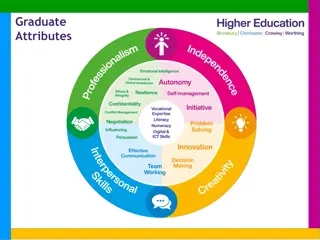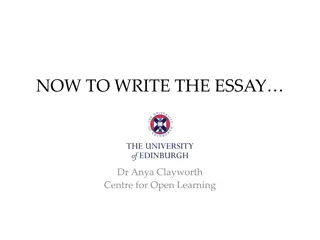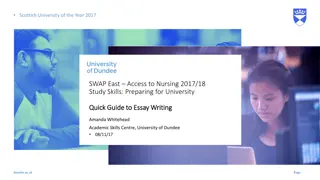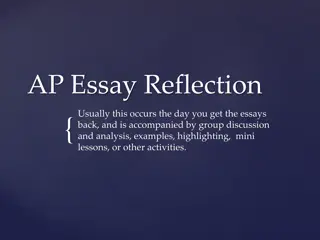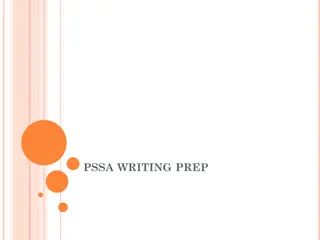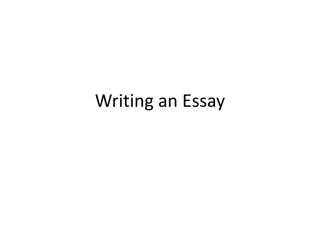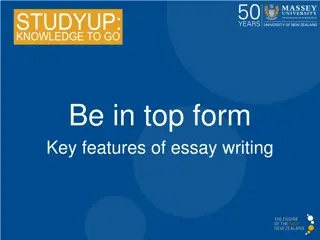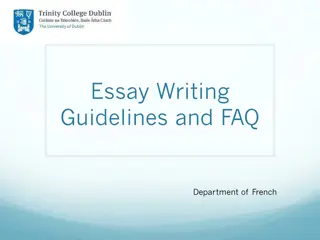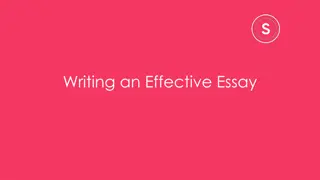Mastering Formal Essay Writing in English 12
Understanding the main components of formal essay writing is essential for English 12 students. This includes discussing content, organization, voice/style, and grammar/mechanics. The quality of the essay is crucial, with a particular focus on clarity, precision, and coherence. Emphasis is placed on logical organization, supported evidence, and effective control of language. The ability to analyze literary works with insight and understanding is key to crafting well-focused and persuasive essays. Utilizing apt textual support and addressing prompts properly are essential for success.
Download Presentation

Please find below an Image/Link to download the presentation.
The content on the website is provided AS IS for your information and personal use only. It may not be sold, licensed, or shared on other websites without obtaining consent from the author.If you encounter any issues during the download, it is possible that the publisher has removed the file from their server.
You are allowed to download the files provided on this website for personal or commercial use, subject to the condition that they are used lawfully. All files are the property of their respective owners.
The content on the website is provided AS IS for your information and personal use only. It may not be sold, licensed, or shared on other websites without obtaining consent from the author.
E N D
Presentation Transcript
FORMAL ESSAY WRITING English 12
KWL FORMAL ESSAYS Write down everything you know about composing a formal essay.
MAIN COMPONENTS OF WRITING Content Organization Voice/Style Grammar/Mechanics
CONTENT What you are saying. Textually correct. Supported with apt & specific evidence. Responds to prompt properly. Well-focused & persuasive. Discuss literary work with significant insight and understanding. Interest Grabber.
ORGANIZATION Logical organization of thoughts. Transitions. Proper elements in appropriate paragraphs. Title/Author intro & conclusion.
VOICE/STYLE How you say it. Correct tense. No 1stperson. Formality. Effective control of language.
GRAMMAR / MECHANICS Underline/italics/quotes. Contractions. No distracting errors.
The score reflects the quality of the essay as a wholeits content, its style, its mechanics. Students are rewarded for what they do well. The score for an exceptionally well-written essay may be raised by 1 point above the otherwise appropriate score. In no case may a poorly written essay be scored higher than a 3. 9 8 These well-focused and persuasive essays identify a tragic character who functions as an instrument of others suffering. These essays also discuss how that suffering contributes to the tragic vision of the work as a whole. Using apt textual support, these essays not only explore the nature of the suffering, but they also analyze how that suffering contributes to the work s tragic vision. Although not without flaws, these essays exhibit the writer s ability to analyze a literary work with insight and understanding, to control a thesis, and to write with clarity, precision, coherence, and - in the case of a nine (9) with particular persuasiveness and/or stylistic flair.
7 6 These competent essays identify a tragic character in an appropriate novel or play and analyze that character s impact on others suffering. They also attempt to articulate how that suffering he or she brings on to others contributes to the work s tragic vision (Work as a Whole). Although these essays have some insight, the analysis provided by the 7 6 essays is less thorough, less perceptive, and/or less specific in supporting detail than that of the 9 -8 essays. References to the text may not be as apt or as persuasive. Essays scored a 7 will demonstrate more sophistication in both substance and in style than those scored a 6, though both 7 s and 6 s will be generally well written and free from significant or sustained misinterpretations.
5 These essays tend to be superficial in analysis even though they may respond to the assigned task and may offer a plausible interpretation of an appropriate novel or play. They often rely upon plot summary that contains some analysis, implicit or explicit. Although they may be obliquely attempt to explain the work as a whlole, the tragic vision, they may demonstrate a rather simplistic understanding of it. Typically, these essays reveal unsophisticated thinking and /or immature writing.
43 These lower-half essays reflect an incomplete or oversimplified understanding of the work discussed, or they may fail to establish how the tragic figure brings about others suffering or how that suffering contributes to the work as a whole. They may rely on plot summary alone. Their assertions may be unsupported or even irrelevant. Often wordy, elliptical, or repetitious, these essays lack control over the elements of college-le el composition. Essays scored a 3 exhibit more than one of the stylistic errors; they may also be marred by significant misinterpretation and /or poor development.
21 These essays compound the weaknesses of the paper in the 4- 3 range. Often, they are unacceptably brief. They may be poorly written on several accounts and contain distracting errors in grammar and mechanics. The writer s remarks are presented with little clarity, organization, or supporting evidence. Especially inept, vacuous, and /or undound essays must be scored a 1. 0 These essays do no more than make a reference to the task. These essays either are left blank or are completely off topic
THESEESSAYSALSODISCUSSHOW THATSUFFERINGCONTRIBUTESTOTHE TRAGICVISIONOFTHEWORKASA WHOLE What is that?????
WORKASA WHOLE It means THEME
THEME A generalization about life
A THEMEWILL: Be a complete sentence.
A THEMEWILL NOT: reference the literature, plot, or characters in any way. Use first person (I, you, me, my, our, us, we) Be a clich Time will tell All is fair in love and war Time heals all wounds
MINI-THEMEVS. THEME
WORKASAWHOLE/THEME MINI-THEME WORKASAWHOLE/THEME A person s commitment to war must be absolute, leaving relationships and other aspects of daily life to be returned to following battle. War All s fair in love in war. When it comes to war, there are no rules.
WORKASAWHOLE/THEME MINI-THEME WORKASAWHOLE/THEME It is during times of hardship that relationships not only test their love, but strengthen it, as well. LOVE Time heals all wounds. As time passes, the inflictions brought on by life tend to restore back to health.
FRANKENSTEIN The Pursuit of Knowledge (Spark) Although knowledge can empower a person; however, that same empowerment can prove their destruction. Tragic people A person only truly becomes tragic when their actions affect not only themselves, but more importantly, others.
FRANKENSTEIN CliffNotes: Sublime Nature (Mini-Theme) Dangerous Knowledge (Mini-Theme) Full Theme: Develop now into full theme: Monstrosity (Mini-Theme)] Full Theme:
PUZZLE PIECES Work as a Whole 1.
WORK BACKWARDS 1. Read prompt ACTIVELY. Really spend time engaging in what the prompt is asking you to do. 2. Make an outline or other organizational structure to sort out your thoughts. 3. Come up with a work as a whole!
WAAW - FRANKENSTEIN 4. Once you have a WAAW, then explain how that Tragic figure brings about suffering to others, thus illuminating that work as a whole.
INTRODUCTION TITLE/AUTHOR INTERESTGRABBER THESIS According to critic Northrop Frye, Tragic heroes are so much the highest points in their human landscape that they seem the inevitable conductors of the power about them, great trees more likely to be struck by lightening than a clump of grass. Conductors may of course be instruments as well as victims of the divine lightening. If Northrop Frye is truly accurate in his account, then the divine lightening of despair strikes rampantly in the town of Geneva, Switzerland. Mary Shelley s Gothic novel Frankenstein showcases a man, Victor Frankenstein, who acts as the conductor of power and tragedy as his selfish actions end up affecting all those whom he loves thus making him truly a tragic figure. Through the horrific sufferings of Victor s father and the monster, Victor is truly not the victim of his doing but the tragic figure that conducts and spreads despair to others in his life. It is through this tragic figure of Frankenstein that Shelley is able to show her audience how a person only truly becomes tragic when their actions affect not only themselves, but more importantly, others.
INTERESTGRABBER According to critic Northrop Frye, Tragic heroes are so much the highest points in their human landscape that they seem the inevitable conductors of the power about them, great trees more likely to be struck by lightening than a clump of grass. Conductors may of course be instruments as well as victims of the divine lightening. If Northrop Frye is truly accurate in his account, then the divine lightening of despair strikes rampantly in the town of Geneva, Switzerland. Mary Shelley s Gothic novel Frankenstein showcases a man, Victor Frankenstein, who acts as the conductor of power and tragedy as his selfish actions end up affecting all those whom he loves thus making him truly a tragic figure. Through the horrific sufferings of Victor s father and the monster, Victor is truly not the victim of his doing but the tragic figure that conducts and spreads despair to others in his life. It is through this tragic figure of Frankenstein that Shelley is able to show her audience how a person only truly becomes tragic when their actions affect not only themselves, but more importantly, others.
TITLEANDAUTHOR According to critic Northrop Frye, Tragic heroes are so much the highest points in their human landscape that they seem the inevitable conductors of the power about them, great trees more likely to be struck by lightening than a clump of grass. Conductors may of course be instruments as well as victims of the divine lightening. If Northrop Frye is truly accurate in his account, then the divine lightening of despair strikes rampantly in the town of Geneva, Switzerland. Mary Shelley s Gothic novel Frankenstein showcases a man, Victor Frankenstein, who acts as the conductor of power and tragedy as his selfish actions end up affecting all those whom he loves thus making him truly a tragic figure. Through the horrific sufferings of Victor s father and the monster, Victor is truly not the victim of his doing but the tragic figure that conducts and spreads despair to others in his life. It is through this tragic figure of Frankenstein that Shelley is able to show her audience how a person only truly becomes tragic when their actions affect not only themselves, but more importantly, others.
WORKASAWHOLE According to critic Northrop Frye, Tragic heroes are so much the highest points in their human landscape that they seem the inevitable conductors of the power about them, great trees more likely to be struck by lightening than a clump of grass. Conductors may of course be instruments as well as victims of the divine lightening. If Northrop Frye is truly accurate in his account, then the divine lightening of despair strikes rampantly in the town of Geneva, Switzerland. Mary Shelley s Gothic novel Frankenstein showcases a man, Victor Frankenstein, who acts as the conductor of power and tragedy as his selfish actions end up affecting all those whom he loves thus making him truly a tragic figure. Through the horrific sufferings of Victor s father and the monster, Victor is truly not the victim of his doing but the tragic figure that conducts and spreads despair to others in his life. It is through this tragic figure of Frankenstein that Shelley is able to show her audience how a person only truly becomes tragic when their actions affect not only themselves, but more importantly, others.
ORGANIZATION According to critic Northrop Frye, Tragic heroes are so much the highest points in their human landscape that they seem the inevitable conductors of the power about them, great trees more likely to be struck by lightening than a clump of grass. Conductors may of course be instruments as well as victims of the divine lightening. If Northrop Frye is truly accurate in his account, then the divine lightening of despair strikes rampantly in the town of Geneva, Switzerland. Mary Shelley s Gothic novel Frankenstein showcases a man, Victor Frankenstein, who acts as the conductor of power and tragedy as his selfish actions end up affecting all those whom he loves thus making him truly a tragic figure. Through the horrific sufferings of Victor s father and the monster, Victor is truly not the victim of his doing but the tragic figure that conducts and spreads despair to others in his life. It is through this tragic figure of Frankenstein that Shelley is able to show her audience how a person only truly becomes tragic when their actions affect not only themselves, but more importantly, others.
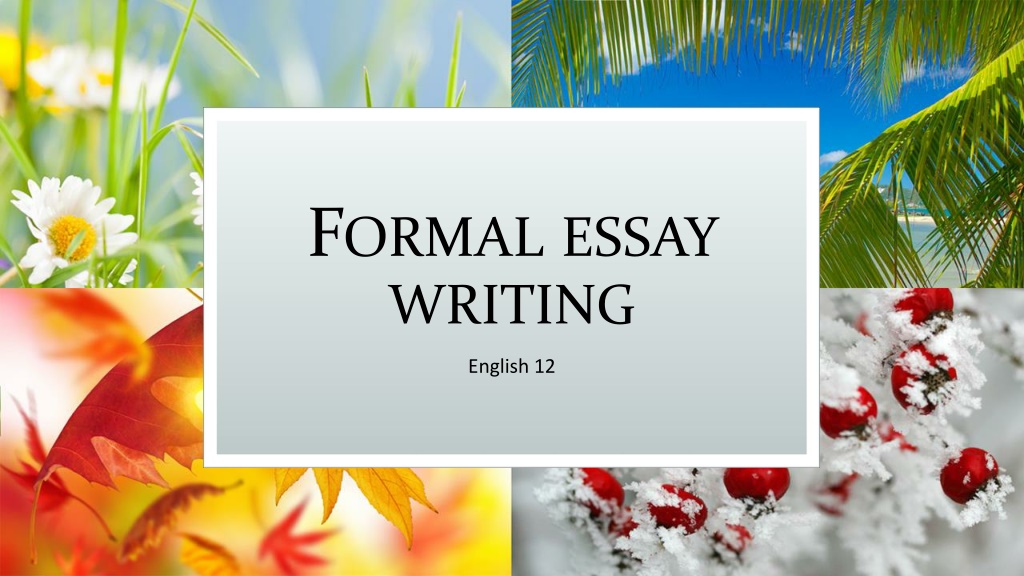
 undefined
undefined










